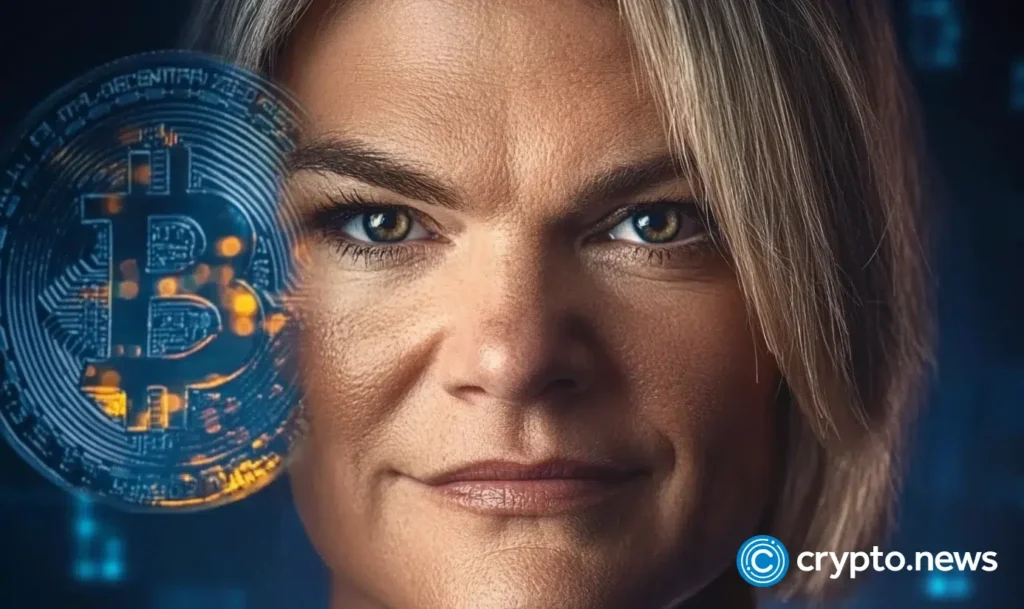Bitcoin reserve advocate Sen. Cynthia Lummis provided critical comments on Jerome Powell’s role in Operation Chokepoint 2.0. Additionally, she echoed Rep. Anna Luna’s allegations concerning Powell’s perjury. Is that a new turn in Donald Trump’s war on Powell?
- Sen. Cynthia Lummis stated the Fed Chairman Jerome Powell mismanaged Operation Chokepoint 2.0
- Lummis supported Rep. Anna Paulina Luna’s perjury allegations, which some see as lawfare against the Fed Chair
- Pressure on Powell continues as President Trump threatens to fire him for not cutting interest rates
Table of Contents
Sen. Lummis’ criticism of Powell
Fox Business anchor Stuart Varney asked Sen. Lummis if rate cut policy disagreements with Powell are worth charging him with perjury, a criminal offense. However, before going to perjury allegations, Sen. Lummis shared a different concern about Powell.
Lummis told Varney:
“I am concerned about the way he handled Chokepoint 2.0, the way that they went after banks that were solvent and drove them into insolvency, the way that the Fed has dealt with using subjective determinations about what banks should be financing, oil, gas, coal, energy, that certain aspects of our economy doesn’t approve of. These are the bigger concerns I have about Jay Powell and the manner in which bank supervision has been conducted.”
Then, Lummis addressed the concerns raised earlier by Rep. Anna Paulina Luna, who referred Jerome Powell to the Department of Justice for alleged perjury associated with the Fed overspending public money on renovating Federal Reserve headquarters building, and Powell allegedly lying about the necessity of costly renovation.
Lummis said Powell was using weasel words while testifying in front of Congress about 39% expense overruns. Lummis named $700 million estimation of these overruns. At the same time, she acknowledged that proving perjury is “very hard,” and he was not under oath when testifying.
On July 18, Rep. Luna claimed she was referring Powell’s case to the DOJ (which she did by July 21), one week after Director of the White House’s Office of Management and Budget Russell Vought sent Powell a letter in which he raised his concerns over excessive costs of the Fed buildings renovation. According to Vought, the current Versailles Palace cost is $3 billion, only half a billion above $2.5 billion spent for the Fed headquarters renovation.
While perjury is a serious accusation, some regarded pressure on Powell as a lawfare against him, as many in the Trump Administration don’t agree with his approach to rate cuts.
Operation Chokepoint 2.0 and Powell’s role in it
Once Operation Chokepoint 2.0 has been considered a conspiracy theory by some, but as the Coinbase team managed to obtain a lot of documents via the Freedom of Information Request, they have found out that during the Biden era the Federal Deposit Insurance Corporation and the DOJ were pressing on banks to halt services for clients associated with cryptocurrency transactions, often without giving a proper explanation. Such practices hindered both crypto business and some of the retail investors.
Although the Federal Reserve was not the main entity behind debanking of crypto clients colloquially called Operation Chokepoint 2.0, it seems that the central bank didn’t do much to protect the banks’ clients. Some companies were accusing the Fed of debanking directly. More than that, crypto companies found it hard to obtain the Fed Master Account that would have made their operations easier. This fact reinforces the perception of the Fed as an enemy of the crypto business. As Jerome Powell has been serving as the Fed Chairman since 2018, he is an easy target for those unsatisfied with the Fed’s remoteness in this case.
Moreover, before 2025, Powell’s remarks on crypto have been pretty skeptical as he was associating the crypto space with fraud and “a lot of turmoil.” As for Operation Chokepoint 2.0, in February, Jerome Powell claimed that debanking was not intentional and vowed to commit to ending unconstitutional debanking practices.
Powell vs. Trump standoff
During 2025, President Trump pressed the Fed Chair to cut rates on many occasions, sometimes using diminishing expressions. For instance, Trump was calling Powell Mr. Too Late or Numbskull.
In the conditions of unavoidable economic turbulence accompanying a tariff war, Donald Trump needs to weaken the American dollar in order to boost international trade of the U.S. However, the Fed, whose mission is to keep inflation in check, sees inflation risks associated with rate cuts as unacceptable. That’s why Powell and his colleagues are not in a hurry to obey Trump. The Fed is trying to bring the inflation rate to the pre-COVID-19 level, which they approached but didn’t accomplish as of July 2025.
So it comes that the Fed’s actions conflict with Trump’s plans on the U.S. economy. He called for Powell to resign and vowed to fire him (and later said he won’t do it). However, it takes a Supreme Court involvement for the President to fire the Federal Reserve Chairman, as the Fed is an independent agency.
The Atlantic staff writer Jonathan Chait offers an unusual look at the nature of Trump’s feud with Powell. Chait notes that Trump complains about the low rates when the President is Democrat and urges the Fed to cut rates when the President is a Republican; hence, he thinks the Fed’s business is slowing down the economy during Democrat administrations and speeding it up when the GOP is ruling the country.
Possible implications of Powell’s resignation
Possible impact of Powell’s resignation may trigger two new reasons for the U.S. dollar inflation to the table:
- First off, the manifestation of such a centralization of power in the U.S. and immense pressure on the independent agency may undermine international trust in the U.S.
- Secondly, if Powell is replaced by a loyalist who cuts rates, inflation may go up just as Powell warned.
USD inflation spikes tend to increase demand pressure on the crypto market as people seek safer savings assets, as happened following the March 2021 stock market collapse triggered by the COVID-19 panic sale. In the event of Powell’s resignation, the crypto market heat-up scenario may occur again.



